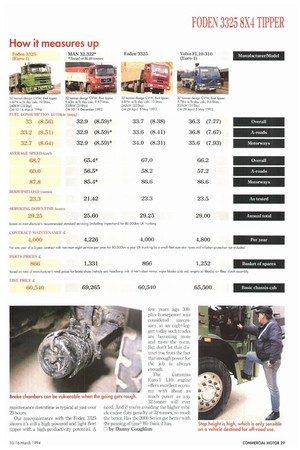MIR 121 ROADTEST 4 4 too, can be stodgy without an air seat to provide some movement.
Page 30

Page 31

If you've noticed an error in this article please click here to report it so we can fix it.
Foden's FF20 system is a development of the Hendrickson Norde original. It includes a so-called roll control device which acts in place of an anti-roll bar on a conventional steel spring suspension. Rubber suspension still requires shock absorbers so apart from a little less greasing and perhaps the reduced threat of damage there's little to gain. Foden's only alternative on double drive is air suspension.
Rubber suits predominantly on-highway operations such as roadstone work, but off road, where the bogie start to articulate you'll find those diff locks essential, especially when unladen. Otherwise steel springs with greater articulation will give better traction. The Foden carries Michelin XZY on/off road tyres as standard.
With its optional Jake retarder and adequate service brakes this eight-wheeler proved easy to rein in at speed. The near automatic action of the Jake whenever the speed hold facility is in use (incorporated with the Groeneveld speed limiter) means the driver can concentrate on the road without worrying too much that the truck is getting carried away with all that power.
Once the speed hold is activated at, for example, 40mph, the Jake cuts in at about 43mph on overrun. Its sound would warn us to cover the brake pedal and glance down at the tacho. A useful but pricey option at £1,400.
• CAB COMFORT At 2,240mm the 3000 Series cab is 257mm (10.1in) narrower than the full-width 40(X) Series cabin. But that means it saves 90kg, more than the weight of the average tipper driver after a good Sunday lunch. Every little helps.
Its spacious and workmanlike. There's a
fair amount of storage space for a day cab yet it's high enough to maintain that big truck feel. The 3000 Series cab is not only light but also corrosion resistant—it's made from fire retardant GRP
with aluminium doors.
Foden has used the cab's slim fit to design a staircaselike entry and exit. The cab floor is recessed inward to improve the entry angle further. The door carries an extra piece of trim to plug the gap when closed.
The dashboard is flatter than in the 4000 Series: the switch and dial layout is essentially the same and there's enough adjustment in the seat and steering column to cosset even the most picky of testers. The interior trim (beefed up after complaints over its resistance to wear and tear) is practical and the visibility from the air-sprung driver's seat is well above average.
All 3000 Series come with heated mirrors; our truck had the optional electric passenger side window as a £70 option. The Jake brake is controlled by an extra unlit rocker switch to the dash, its operation being otherwise automatic.
• SUMMARY Foden's spec and pricing structures are straightforward enough once you understand how they work. However, they do make for tricky comparisons with other manufacturers.
The 3000 Series' £60,540 base price looks attractive but don't be fooled. It only buys you the lower rated L275 engine and nine-speed Fuller box.
It also doesn't include basics such as the flitching and tipper body hinge. Add these and the list price for a standard tipper chassis cab to the L325/Twin Spliiter driveline combination tested here and the figure rises to £62,815. And that's before slack adjusters or a driver's air seat are added.
On the plus side Foden's parts prices are commendably low. This is reflected in the annual contract maintenance charge: £4,000 for 80,000km (20°6 off road). The first year maintenance downtime is typical at just over 29 hours.
Our reacquaintance with the Foden 3325 shows it's still a high powered and light fleet tipper with a high productivity potential. A
few years ago 300plus horsepower was considered unecessary in an eight-legger: today such trucks are becoming more and more the norm. But don't let that distract you from the fact that enough power for the job is always enough.
The Cummins Euro4 L10 engine offers excellent economy with about as much power as any 32-tonner will ever need. And if you're avoiding the higher vehicle excise duty penalty at 32 tonnes, so much the better. Has the 3000 Series got better with the passing of time? We think it has.
E by Danny Coughlan




















































































